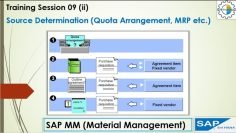This video provides an in-depth understanding of the organizational structure in SAP Materials Management (MM) and its importance in a successful SAP implementation. Here are the key points:
- Importance of Organizational Structure: The organizational structure is crucial for a successful implementation of SAP. It should accurately map the organizational structure of the company into the SAP system, considering both the legal aspects and the reporting needs of the company. It should also be flexible enough to accommodate future expansions and growth.
- SAP Organizational Structure: The SAP organizational structure is mapped to the business functions. The structure starts with the client, followed by the company code, plant, and storage location. Other elements include purchasing organization and purchasing group.
- Client: The client is the highest element of the SAP system’s organizational structure. It represents a company or group of companies with several independent company units. The client is an organizational and legal entity in the SAP system, and the master data are protected within the client.
- Company Code: The company code is a legal entity that prepares legal and financial statements. It can contain one or more plants. The company code is responsible for the profit and loss statement and the balance sheet.
- Plant: The plant is an operational unit within a company code. It can be a manufacturing unit, a branch office, or a storage location. The plant is responsible for physical production, managing inventory, managing demand, and planning production.
- Purchasing Organization: The purchasing organization is responsible for procuring materials or services for one or more plants and negotiating general conditions of purchase. It can be assigned to multiple plants.
- Purchasing Group: The purchasing group is a subdivision of the purchasing organization responsible for day-to-day purchasing activities.
- Valuation Area: The valuation area is the organizational level at which material is evaluated. SAP recommends valuating the material at the plant level.
- Sales Organization, Distribution Channel, and Division: These are other elements of the organizational structure defined by the sales and distribution consultants. They are combined to form a sales area.
- Controlling Area: The controlling area is defined within the controlling module. It represents a full, self-contained cost accounting system and an internal reporting structure.



























































